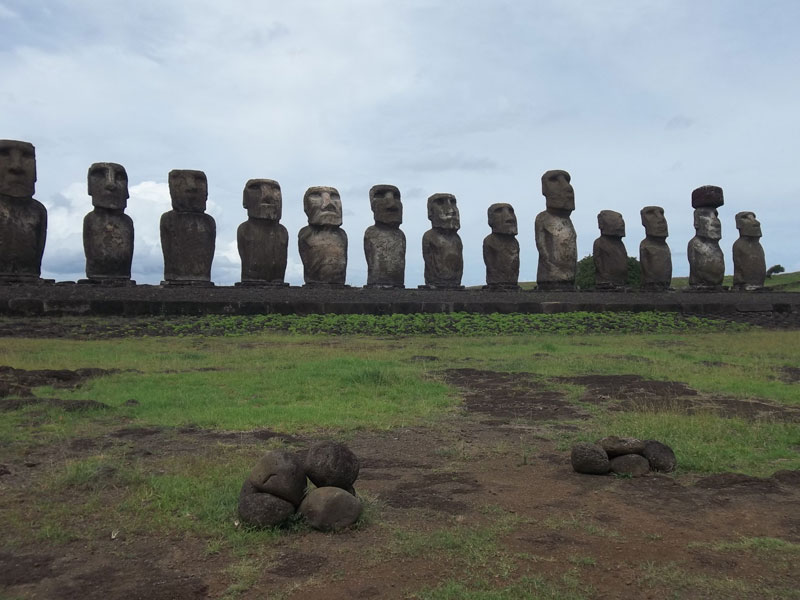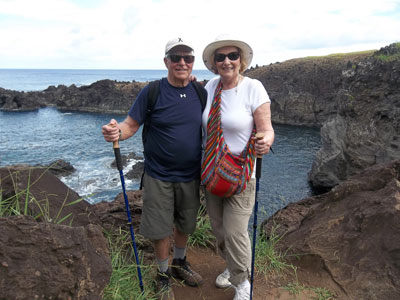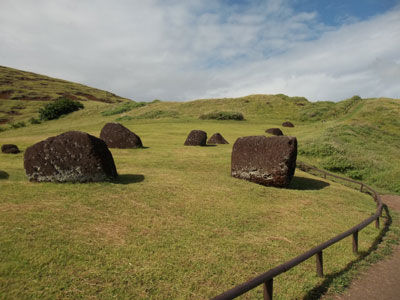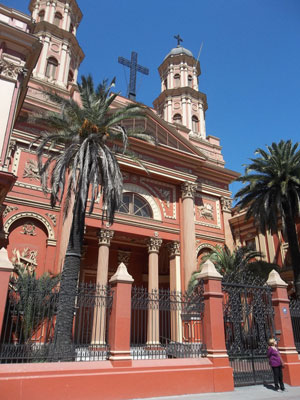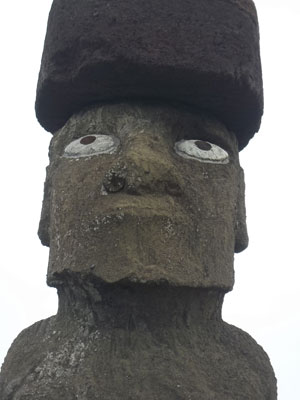Enticed by the mystery of Easter Island
This article appears on page 18 of the March 2015 issue.
As part of a March 2014 South American adventure, which included several days in Santiago, Chile, and a cruise from the city of Valparaíso to Los Angeles, my wife, Judy, and I spent six nights on Easter Island (called Rapa Nui by its residents and Isla de Pascua by Chileans).
We were enticed to devote the time and expense for this journey by the books and articles we read about the place and its history, the numerous documentary films we watched on cable television and the many mysteries surrounding the island. Not the least of its attractions is that it is one of the most isolated inhabited islands in the world, sitting in the Pacific Ocean about 2,500 miles west of Santiago.
Getting there
We flew to Miami on American Airlines, with a connecting flight to Santiago. Our connection was delayed eight hours, which might have jeopardized our making our LAN flight from Santiago to Easter Island had we not planned an extra day for travel to compensate for weather and other airline-related delays.
We stayed overnight at the modern and well-run Holiday Inn ($200, including breakfast) at Santiago’s airport, so we needed only to walk across the street to catch our morning flight on LAN (about $700 each, round trip).
For our accommodation on Easter Island, we booked, via the Internet, the top-floor unit at Te’Ora (www.rapanuiteora.com), a 3-unit complex just north of Hanga Roa, the town on the island where the majority of the population lives and works.
The island measures just 7 by 15 miles, so it was easy to find a place to stay that fronted the ocean. Our apartment was a large room with a well-equipped kitchen, very slow Wi-Fi and a wonderful outdoor porch where we sat and watched the Pacific Ocean pound against the rocks below.
The price of the room, payable only in cash, was quoted in Chilean pesos, so it was important to know the conversion rate. We paid about $140 per night; we had hoped to pay a bit less. This, however, was more than compensated for by the fact that the “reciprocal tax” previously levied by Chile on US citizens entering the country had been repealed just as we left for our trip, saving us $160 each. What a nice surprise!
Settling in
We were met at the airport and presented with welcome leis by Vi, the manager of Te’Ora, who is, along with much of the resident population, of Polynesian lineage. We stopped at the kiosk at the airport to purchase our national park passes ($60 each), allowing us to visit parts of the island that are important to its history and culture.
On the way to Te’Ora, we stopped at a mini-mart to buy some food. As we often have done when we travel, we intended to cook our own meals for part of our stay.
Restaurant meals in Hanga Roa can be quite expensive, and we welcomed this opportunity to economize. More importantly, we have found that the experience of shopping for food and cooking it in a foreign country helps us connect to the local culture.
After spending the rest of the day settling in, we called Vi (there was a phone on the premises that we could use to call her cell phone) and asked her help in lining up a rental car for later in the week. We also reported a hot water issue, which was quickly remedied.
Exploring on foot
The next day, our first complete day on the island, we packed sandwiches for lunch and set out walking south along the coast road until we came to our first moai, one of around 900 statues carved by the natives of the island from about AD 1200 to 1600.
It is believed that these huge sculptures, some weighing up to 80 tons, were built to represent the natives’ ancestors. They were placed on platforms called ahus, and they faced inland with their backs to the sea so their spirits could overlook and protect their living descendants.
We continued to walk south until we reached Ana Kai Tangata, a cave where it was theorized (later debunked) that cannibalism had taken place. We walked down to the cave, where the water crashing on the rocks below was a nice payoff.
Pressing on toward Orongo Village, we hiked up to the crater called Rano Kau, a volcanic caldera shallowly filled with water and vegetation, with the sea behind it.
Tired, we then retraced our steps back to our apartment.
The following morning we were picked up at Te’Ora by a representative of the car rental company (Rapa Nui Oceanic Car Rental) and driven to their office in Hanga Roa. We rented a 4-wheel-drive manual-transmission Suzuki for CLP30,000 ($48) per day. I put in $10 worth of gas, which lasted us the entire time we had the vehicle
Insurance on the vehicle was not offered or included in the price. Whatever coverage was offered by our credit card (adding an additional 2% to the cost) was our only protection. (For what it’s worth, there is little traffic on the roads, and the wild horses on the island are probably the greatest hazard to drivers.)
We spent the day touring various sites on the island. The best were Anakena Beach, a beautiful sheet of clean white sand overseen by several moai, and Tongariki, a huge ahu of 15 moai overlooking a plain. One of the moai was equipped with a topknot made of red volcanic stone.
An exhibit of fallen topknots was nearby along with the “Traveling Moai” that was lent to Japan for an exhibition.
As we drove around the island, we felt there was a lack of signage to explain many of the various sites. Having heard that before we left home, we had downloaded “A Companion to Easter Island” by James Grant-Peterkin to our digital reader. This book gives complete explanations and historical background on all the sites on Easter Island.
James resides on the island and conducts tours, which vary in price depending on the length of the tour and the number of people. Using the book, Judy and I toured the sites on our own.
Barriers set up in front of some of the moai prohibit visitors from getting close enough to see the engravings on them, so it’s a good idea to pack a small pair of binoculars so you can see the details without violating the barriers.
A few finds
On the way back to our apartment, we stopped at the mini-mart to get more supplies and noticed that it was difficult to find some foods we were used to having at home, including packaged bread and milk (though dry milk was readily available). Also missing were the cuts of beef and pork that you might find in other places in the world.
In speaking to other travelers on the island, we heard that the restaurant food not only was overpriced but was not very well prepared. But we wanted to try a local specialty, a tuna empanada, and found it very tasty. 
A good and relatively inexpensive place to try this dish is Ariki o Te Pana, located on the main street in Hanga Roa. In an inside kitchen, Tia Berta was busy cooking empanadas for the customers sitting outside on the pleasant porch. A huge empanada and a bottle of water cost about $6.
The March temperatures reached the upper 70s (F) during the day and fell to the low 60s at night. For the most part, the weather was dry, but when it rained, the downpour was long and steady and turned some of the roads to thick mud.
The following day we missed the sunrise due to heavy rainstorms, but we braved the threat of even more rain to visit the important site of Rano Raraku, the quarry in which the moai were created. There we saw hundreds of moai, some broken, some mostly buried and others almost ready to “walk” to an appointed ahu to gaze eternally upon the people.
Departing Rano Raraku, we visited some less prominent sites suggested by the guidebook. One was Akahanga, situated along a particularly beautiful stretch of oceanfront. The best part of the site was the magnificent view of the blue Pacific crashing in towering white splashes against the dark rocks bordering the green meadow.
Island culture
That evening we went to the Kari Kari dance show (CLP15,000 per person), held in its own building set back off the main street. The 90-minute show featured Polynesian-type dances and good costumes, lighting and makeup. The troupe was very energetic, and we thought it was well worth the expense.
After the show — which was, incidentally, sold out — the audience was invited on stage to pose for pictures with the cast.
A second visit to the Rano Kau caldera was on the agenda the next day. We headed about a mile down the road, where our national park entry passes were stamped. This allowed us to enter the site, which overlooks three islands that were important in the “birdman” period of the history of Rapa Nui.
After centuries of wars amongst the various clans seeking to rule the island, it was determined that the issue be settled by staging a contest where a representative of each clan would dive into the sea and swim to an island to obtain the first egg of the season laid by a sooty tern, a species of bird that once nested there. The winner’s tribe would govern the island for the year.
When our time on the island came to an end, Vi presented us with a traditional farewell gift of a black enameled shell, found only on the island, with an affixed rooster feather.
The feeling of warmth and tradition and the mysterious culture of the people are things we will long remember.

